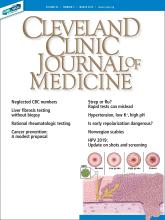Article Figures & Data
Tables
Condition Frequency Rheumatoid arthritis 70% Other autoimmune rheumatic conditions Primary Sjögren syndrome 75%–95% Systemic lupus erythematosus 15%–35% Systemic sclerosis 20%–35% Systemic vasculitis 5%–20% Infectionsa Infective endocarditis 40% Syphilis 8%–37% Hepatitis B 25% Hepatitis C 76% Human immunodeficiency virus infection 10%–20% Tuberculosis 15% Other diseases Liver cirrhosis 25% Mixed cryoglobulinemia 100% Primary biliary cirrhosis 45%–70% Healthy people 5%–25%b Pathogenesis Examples of disease manifestations Nonspecific inflammatory response Fever, fatigue, arthralgia, weight loss, anemia of chronic disease, elevated erythrocyte sedimentation rate Immune complex deposition (commonly in the synovium, skin, serosa, kidneys, and lungs) Inflammatory arthritis, photosensitive skin rashes, pleurisy, pericarditis, glomerulonephritis, pneumonitis, or interstitial lung disease Direct antibody-mediated attack Hemolytic anemia (red cell antibodies), thrombocytopenia (antiplatelet antibodies), lymphopenia (lymphocytotoxic antibodies), neuropsychiatric manifestations such as depression and psychosis (antiribosomal P antibodies) Associated features Recurrent thrombosis and miscarriages (antiphospholipid syndrome), dry eyes and mouth (Sjögren syndrome) Laboratory clues Hemolytic anemia, leukopenia, lymphopenia, thrombocytopenia, elevated erythrocyte sedimentation rate, normal C-reactive protein, low complement (due to immune complex formation), and abnormal urinalysis (proteinuria, hematuria, red cell casts, or dysmorphic red cells) Antigen target Disease association Double-stranded DNA and Sm Systemic lupus erythematosus Ro and La Sjögren syndrome; Ro also associated with subacute cutaneous lupus U1-RNP Mixed connective tissue disease Jo-1 Polymyositis (higher risk of interstitial lung disease) ScL-70 Diffuse cutaneous scleroderma Anticentromere Limited cutaneous scleroderma Unprovoked deep vein thrombosis or pulmonary embolism
(Antiphospholipid antibody testing is not recommended in patients with provoked venous thrombosis, as there is insufficient evidence to recommend long-term anticoagulation.)Ischemic stroke (including transient ischemic attack) in patients under age 50 Patients with both arterial and venous events Recurrent thrombosis Thrombosis in an unusual site Pregnancy morbidity
(1 or more unexplained deaths of a morphologically normal fetus at or beyond the 10th week of gestation; 1 or more premature births of a morphologically normal neonate before the 34th week of gestation because of preeclampsia, eclampsia, or placental insufficiency; or 3 or more unexplained consecutive spontaneous abortions before the 10th week of gestation)All patients with systemic lupus erythematosus ↵a Knowledge of the antiphospholipid antibody status helps to decide if low-dose aspirin should be recommended for primary prevention of thrombosis.32 Lupus anticoagulant is likely to be falsely positive in those with acute thrombosis and those receiving anticoagulant therapy. Hence, anticoagulant therapy should be interrupted for at least 7 days before testing for lupus anticoagulant. However, anticardiolipin and anti-beta-2 glycoprotein I can be tested at any time, as they are not affected by thrombosis or anticoagulant therapy.
Glomerulonephritis Pulmonary hemorrhage (especially with pulmonary-renal syndrome) Multiple lung nodules Mononeuritis multiplex or unexplained peripheral neuropathy Cutaneous vasculitis, especially with systemic features Scleritis Retroorbital mass Chronic destructive disease of the upper airways Chronic sinusitis or otitis Subglottic tracheal stenosis - TABLE 6
Conditions associated with antineutrophil cytoplasmic antibody (ANCA) other than ANCA-associated vasculitis
Gastrointestinal disorders
Inflammatory bowel disease
Primary sclerosing cholangitis
Primary biliary cirrhosis
Autoimmune hepatitis
Viral hepatitisInfections
Infective endocarditis
Tuberculosis
MalariaDrugs
Propylthiouracil
Minocycline
Hydralazine
Allopurinol
LevamisoleAutoimmune diseases
Rheumatoid arthritis
Systemic lupus erythematosus (SLE)a
Antiglomerular basement membrane disease↵a Antinuclear antibody (ANA) and p-ANCA resemble each other closely and are difficult to differentiate. Thus, SLE sera may show positive p-ANCA staining due to presence of ANA.
Inflammatory back pain Arthritis Enthesitis of the heel Dactylitis Uveitis Psoriasis Inflammatory bowel disease Good response to nonsteroidal anti-inflammatory medication Family history of spondyloarthritis Positive HLA-B27 Elevated C-reactive protein






